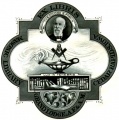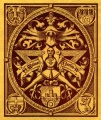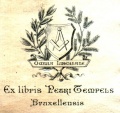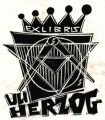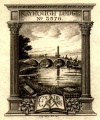En:Masonic Bookplates: Unterschied zwischen den Versionen
(Die Seite wurde neu angelegt: „thumb|Bookplate made by Bro [[Jens Rusch for AF&AM-Lodge St. Michael am Strom in Hamburg]] thumb|left == Exlibris …“) |
K (Sprachverweis beigefügt, externen Link als solchen sichtbar gemacht) |
||
| (2 dazwischenliegende Versionen von 2 Benutzern werden nicht angezeigt) | |||
| Zeile 1: | Zeile 1: | ||
[[Bild:0c46c260.jpg|thumb|Bookplate made by Bro [[Jens Rusch]] for AF&AM-Lodge St. Michael am Strom in Hamburg]] | [[Bild:0c46c260.jpg|thumb|Bookplate made by Bro [[Jens Rusch]] for AF&AM-Lodge St. Michael am Strom in Hamburg]] | ||
[[Datei:Exlibris12.jpg|thumb|left]] | [[Datei:Exlibris12.jpg|thumb|left]] | ||
| Zeile 62: | Zeile 63: | ||
== England == | == England == | ||
In many ways the consideration of the English bookplate, in its numerous styles, from the late Elizabethan to the late Victorian period, is particularly interesting. In all its varieties it reflects with great fidelity the prevailing taste in decorative art at different epochs - as bookplates do in all countries. Of English examples, none thus far seems to have been discovered of older date than the gift plate of Sir Nicholas Bacon; for the celebrated, gorgeous, hand-painted armorial device attached to a folio that once belonged to Henry VIII, and now is located in the King's library, British Museum, does not fall in the category of bookplates in its modern sense. The next is that of Sir Thomas Tresham, dated 1585. Until the last quarter of the 17th century the number of authentic English plates is very limited. Their composition is always remarkably simple, and displays nothing of the German elaborateness. They are as a rule very plainly armorial, and the decoration is usually limited to a symmetrical arrangement of mantling, with an occasional display of palms or wreaths. Soon after the Restoration, however, a bookplate seems to have suddenly become an established accessory to most well-ordered libraries. | In many ways the consideration of the English bookplate, in its numerous styles, from the late Elizabethan to the late Victorian period, is particularly interesting. In all its varieties it reflects with great fidelity the prevailing taste in decorative art at different epochs - as bookplates do in all countries. Of English examples, none thus far seems to have been discovered of older date than the gift plate of Sir Nicholas Bacon; for the celebrated, gorgeous, hand-painted armorial device attached to a folio that once belonged to Henry VIII, and now is located in the King's library, British Museum, does not fall in the category of bookplates in its modern sense. The next is that of Sir Thomas Tresham, dated 1585. Until the last quarter of the 17th century the number of authentic English plates is very limited. Their composition is always remarkably simple, and displays nothing of the German elaborateness. They are as a rule very plainly armorial, and the decoration is usually limited to a symmetrical arrangement of mantling, with an occasional display of palms or wreaths. Soon after the Restoration, however, a bookplate seems to have suddenly become an established accessory to most well-ordered libraries. | ||
| Zeile 81: | Zeile 81: | ||
== Art == | == Art == | ||
Until the advent of bookplate collectors and their frenzy for exchange, the devising of bookplates was almost invariably left to the routine skill of the heraldic-stationery salesman. Near the turn of the 20th century, the composition of personal book tokens became recognized as a minor branch of a higher art, and there has come into fashion an entirely new class of designs which, for all their wonderful variety, bear as unmistakable a character as that of the most definite styles of bygone days. Broadly speaking, it may be said that the purely heraldic element tends to become subsidiary and the allegorical or symbolic to assert itself more strongly. | Until the advent of bookplate collectors and their frenzy for exchange, the devising of bookplates was almost invariably left to the routine skill of the heraldic-stationery salesman. Near the turn of the 20th century, the composition of personal book tokens became recognized as a minor branch of a higher art, and there has come into fashion an entirely new class of designs which, for all their wonderful variety, bear as unmistakable a character as that of the most definite styles of bygone days. Broadly speaking, it may be said that the purely heraldic element tends to become subsidiary and the allegorical or symbolic to assert itself more strongly. | ||
| Zeile 88: | Zeile 87: | ||
== Study and collection == | == Study and collection == | ||
Bookplates are very often of high interest (and of a value often far greater than the odd volume in which they are found affixed), either as specimens of bygone decorative fashion or as personal relics of well-known people. However the value attached to book plates, otherwise than as an object of purely personal interest, is comparatively modern. | Bookplates are very often of high interest (and of a value often far greater than the odd volume in which they are found affixed), either as specimens of bygone decorative fashion or as personal relics of well-known people. However the value attached to book plates, otherwise than as an object of purely personal interest, is comparatively modern. | ||
| Zeile 114: | Zeile 112: | ||
== Links == | == Links == | ||
* | *Masonic Bookplates http://www.phoenixmasonry.org/masonicmuseum/masonic_bookplates.htm | ||
[[Kategorie: | |||
{{Languages|Freimaurer-Exlibris|Deutsch}} | |||
[[Kategorie:Art|Masonic Bookplates]] | |||
Aktuelle Version vom 2. Juni 2016, 08:17 Uhr

Exlibris
Masonic bookplate bookplates are probably the rarest of all genres. This collection belonging to Brother Jens Rusch is therefore a small but valuable selection. Formerly it was reserved for monastery libraries to declare ownership. In these specimens there are also the official bookplate of UGLE-library.
Exlibris-Gallery
Detailed definition
The following is a detailed definition from Wikipedia.
A bookplate, also known as ex-librīs [Latin, "from the books of..."], is usually a small print or decorative label pasted into a book, often on the inside front cover, to indicate its owner. Simple typographical bookplates are termed 'booklabels'.
Bookplates typically bear a name, motto, device, coat-of-arms, crest, badge, or any motif that relates to the owner of the book, or is requested by him from the artist or designer. The name of the owner usually follows an inscription such as "from the books of . . . " or "from the library of . . . ", or in Latin, ex libris .... Bookplates are important evidence for the provenance of books.
The earliest known marks of ownership of books or documents date from the reign of Amenophis III in Egypt (1391-1353). However, in their modern form, they evolved from simple inscriptions in books which were common in Europe in the Middle Ages, when various other forms of "librarianship" became widespread (such as the use of class-marks, call-numbers, or shelfmarks). The earliest known examples of printed bookplates are German, and date from the 15th century. One of the best known is a small hand-coloured woodcut representing a shield of arms supported by an angel, which was pasted into books presented to the Carthusian monastery of Buxheim by Brother Hildebrand Brandenburg of Biberach, about the year 1480—the date being fixed by that of the recorded gift. The woodcut, in imitation of similar devices in old manuscripts, is hand-painted. An example of this bookplate can be found in the Farber Archives of Brandeis University[1] . In France the most ancient ex-libris as yet discovered is that of one Jean Bertaud de la Tour-Blanche, the date of which is 1529. Holland comes next with the plate of Anna van der Aa, in 1597; then Italy with one attributed to the year 1622. The earliest known American example is the plain printed label of John Williams, 1679.
England
In many ways the consideration of the English bookplate, in its numerous styles, from the late Elizabethan to the late Victorian period, is particularly interesting. In all its varieties it reflects with great fidelity the prevailing taste in decorative art at different epochs - as bookplates do in all countries. Of English examples, none thus far seems to have been discovered of older date than the gift plate of Sir Nicholas Bacon; for the celebrated, gorgeous, hand-painted armorial device attached to a folio that once belonged to Henry VIII, and now is located in the King's library, British Museum, does not fall in the category of bookplates in its modern sense. The next is that of Sir Thomas Tresham, dated 1585. Until the last quarter of the 17th century the number of authentic English plates is very limited. Their composition is always remarkably simple, and displays nothing of the German elaborateness. They are as a rule very plainly armorial, and the decoration is usually limited to a symmetrical arrangement of mantling, with an occasional display of palms or wreaths. Soon after the Restoration, however, a bookplate seems to have suddenly become an established accessory to most well-ordered libraries.
The first recorded use of the phrase book plate was in 1791 by John Ireland in Hogarth Illustrated. Bookplates of that period offer very distinctive characteristics. In the simplicity of their heraldic arrangements they recall those of the previous age; but their physiognomy is totally different. In the first place, they invariably display the tincture lines and dots, after the method originally devised in the middle of the century by Petra Sancta, the author of Tesserae Genlilitiae, which by this time had become adopted throughout Europe. In the second, the mantling assumes a much more elaborate appearance—one that irresistibly recalls that of the periwig of the period surrounding the face of the shield. This style was undoubtedly imported from France, but it assumed a character of its own in England.
As a matter of fact, from then until the dawn of the French Revolution, English modes of decoration in bookplates, as in most other chattels, follow at some years' distance the ruling French taste. The main characteristics of the style which prevailed during the Queen Anne and early Georgian periods are: ornamental frames suggestive of carved oak, a frequent use of fish-scales, trellis or diapered patterns, for the decoration of plain surfaces; and, in the armorial display, a marked reduction in the importance of the mantling. The introduction of the scallop-shell as an almost constant element of ornamentation gives already a foretaste of the Rocaille-Coquille, the so-called Chippendale fashions of the next reign.
As a matter of fact, during the middle third of the century this rococo style (of which the Convers plate gives a typical sample) affects the bookplate as universally as all other decorative objects. Its chief element is a fanciful arrangement of scroll and shell work with curveting acanthus-like sprays — an arrangement which in the examples of the best period is generally made asymmetrical in order to give freer scope for a variety of countercurves. Straight or concentric lines and all appearances of flat surface are studiously avoided; the helmet and its symmetrical mantling tends to disappear, and is replaced by the plain crest on a fillet. The earlier examples of this manner are tolerably ponderous and simple. Later, however, the composition becomes exceedingly light and complicated; every conceivable and often incongruous element of decoration is introduced, from cupids to dragons, from flowerets to Chinese pagodas. During the early part of George III.'s reign there is a return to greater sobriety of ornamentation, and a style more truly national, which may be called the urn style, makes its appearance.
Bookplates of this period have invariably a physiognomy which at once recalls the decorative manner made popular by architects and designers such as Chambers, the Adams, Josiah Wedgwood, Hepplewhite and Sheraton. The shield shows a plain spade-like outline, manifestly based upon that of the pseudo-classic urn then very alive. The ornamental accessories are symmetrical palms and sprays, wreaths and ribands. The architectural boss is also an important factor. In many plates, indeed, the shield of arms takes quite a subsidiary position by the side of the predominantly architectural urn.
From the beginning of the 19th century, no special style of decoration seems to have established itself. The immense majority of examples display a plain shield of arms with motto on a scroll, and crest on a fillet. At the turn of the 20th century, however, a rapid impetus appears to have been given to the designing of ex-libris; a new era, in fact, had begun for the bookplate, one of great interest.
The main styles of decoration (and these, other data being absent, must always in the case of old examples remain the criteria to date) have already been noticed. It is, however, necessary to point out that certain styles of composition were also prevalent at certain periods. Although the majority of the older plates were armorial, there were always pictorial examples as well, and these are the quasi-totality of modern ones.
Of this kind the best-defined English genre may be recalled: the library interior—a term which explains itself—and book-piles, exemplified by the ex-libris of W. Hewer, Samuel Pepys's secretary. We have also many portrait-plates, of which, perhaps, the most notable are those of Samuel Pepys himself and of John Gibbs, the architect; allegories, such as were engraved by Hogarth, Bartolozzi, John Pine and George Vertue; landscape-plates, by wood-engravers of the Bewick school, &c. In most of these the armorial element plays but a secondary part.
Art
Until the advent of bookplate collectors and their frenzy for exchange, the devising of bookplates was almost invariably left to the routine skill of the heraldic-stationery salesman. Near the turn of the 20th century, the composition of personal book tokens became recognized as a minor branch of a higher art, and there has come into fashion an entirely new class of designs which, for all their wonderful variety, bear as unmistakable a character as that of the most definite styles of bygone days. Broadly speaking, it may be said that the purely heraldic element tends to become subsidiary and the allegorical or symbolic to assert itself more strongly.
Among early 20th-century English artists who have more specially paid attention to the devising of bookplates, may be mentioned C. W. Sherborn, G. W. Eve, Robert Anning Bell, J. D. Batten, Erat Harrison, J. Forbes Nixon, Charles Ricketts, John Vinycomb, John Leighton and Warrington Hogg and Frank C. Papé. The development in various directions of process work, by facilitating and cheapening the reproduction of beautiful and elaborate designs, has no doubt helped much to popularize the bookplate — a thing which in older days was almost invariably restricted to ancestral libraries or to collections otherwise important. Thus the great majority of plates of the period 1880-1920 plates were reproduced by process. Some artists continued to work with the graver. Some of the work they produce challenges comparison with the finest productions of bygone engravers. Of these the best-known are C. W. Sherborn (see Plate) and G. W. Eve in England, and in America J. W. Spenceley of Boston, Mass., K. W. F. Hopson of New Haven, Conn., and E. D. French of New York City.
Study and collection
Bookplates are very often of high interest (and of a value often far greater than the odd volume in which they are found affixed), either as specimens of bygone decorative fashion or as personal relics of well-known people. However the value attached to book plates, otherwise than as an object of purely personal interest, is comparatively modern.
The study of and the taste for collecting bookplates hardly date farther back than the year 1860. The first real impetus was given by the appearance of A Guide to the Study of Book-Plates (Ex-Libris), by Lord de Tabley (then the Hon. J. Leicester Warren M.A.) in 1880 (published in London by John Pearson of 46 Pall Mall). This work, highly interesting from many points of view, established what is now accepted as the general classification of styles of British ex-libris: early armorial (i.e., previous to Restoration, exemplified by the Nicholas Bacon plate); Jacobean, a somewhat misleading term, but distinctly understood to include the heavy decorative manner of the Restoration, Queen Anne and early Georgian days (the Lansanor plate is Jacobean); Chippendale (the style above described as rococo, tolerably well represented by the French plate of Convers); wreath and ribbon, belonging to the period described as that of the urn, &c. Since then the literature on the subject has grown considerably.
Societies of collectors were founded, first in England in 1891, then in Germany and France, and later in the United States, most of them issuing a journal or archives: The Journal of the Ex-libris Society (London), the Archives de la Société française de collectionneurs d'ex-libris (Paris), both of these monthlies; the Ex-libris Zeitschrift (Berlin), a quarterly.
In 1901-1903 the British Museum published the catalog of the 35,000 bookplates collected by Sir Augustus Wollaston Franks (1826-97).
Bookplates, of which there are probably far more than a million extant examples worldwide, have become objects of collection. One of the first known English collectors was a Miss Maria Jenkins of Clifton, Bristol, who was active in the field during the second quarter of the 19th century. Her bookplates were later incorporated into the collection of Joseph Jackson Howard.
Some collectors attempt to acquire plates of all kinds (for example, the collection of Irene Dwen Andrews Pace, now at Yale University, comprising 250,000 items). Other collectors prefer to concentrate on bookplates in special fields—for example, coats of arms, pictures of ships, erotic plates, chess pieces, legal symbols, scientific instruments, signed plates, proof-plates, dated plates, plates of celebrities, or designs by certain artists. Contemporary bookplates and their collection
Since the 1950s, there has been a renewed interest in the collection of bookplates and in many ways a reorientation of this interest. There are still substantial numbers of collectors for whom the study of bookplates spanning 500 years is a fascinating source of historical, artistic and socio-cultural interest. They have however been joined by a now dominant group of new collectors whose interest is more than anything the constitution - at quite reasonable cost - of a miniature, personalized art-print collection. In this miniature art museum, they gather together the works of their favorite artists. They commission numbered and signed editions of bookplates to their name which are never pasted into books but only serve for exchange purposes.
More than 50 'national' societies of ex-libris collectors exist, grouped into an International Federation of Ex-libris Societies (FISAE) which organizes worldwide congresses every two years. Source: Wikipedia
Books
Exlibriskunst und Graphik Jahrbuch 1989 (Frankfurt/Main 1989) Beiträge über: Gerhart Hauptmann, Freimaurerische Exlibris, Rudolf Rieß, Jan Meeus, Vlastimil Kacírek, András Bánsági; Originale von R. Rieß, Jan Meeus, Kacírek, W. Wassiljewitsch and more. Softcover, 30 x 21 cm, 72 Seiten, 130 Abb. Erhältlich bei SCHOPF
Links
- Masonic Bookplates http://www.phoenixmasonry.org/masonicmuseum/masonic_bookplates.htm












